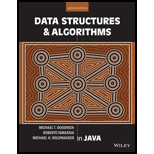
Explanation of Solution
Flawed method implementation:
Let us make the assumption that, in the code fragment 1.5 in the textbook the following instance variable “balance” is changed to private visibility.
//Create a main class
public class CreditCard
{
//Declare the instance variable
private double balance;
}
Program:
The following code is the subclass PredatoryCreditcard extended from CreditCard class. While changing the instance variable “balance” to private visibility in main class CreditCard, the following method leads to an error:
//Create a sub class PredatoryCreditCard
public class PredatoryCreditCard extends CreditCard
{
// Override the charge()method from superclass
public boolean charge(double price)
{
//Call inherited method
boolean isSuccess = super...
Want to see the full answer?
Check out a sample textbook solution
Chapter 2 Solutions
Data Structures and Algorithms in Java
 Microsoft Visual C#Computer ScienceISBN:9781337102100Author:Joyce, Farrell.Publisher:Cengage Learning,
Microsoft Visual C#Computer ScienceISBN:9781337102100Author:Joyce, Farrell.Publisher:Cengage Learning, C++ Programming: From Problem Analysis to Program...Computer ScienceISBN:9781337102087Author:D. S. MalikPublisher:Cengage Learning
C++ Programming: From Problem Analysis to Program...Computer ScienceISBN:9781337102087Author:D. S. MalikPublisher:Cengage Learning EBK JAVA PROGRAMMINGComputer ScienceISBN:9781337671385Author:FARRELLPublisher:CENGAGE LEARNING - CONSIGNMENT
EBK JAVA PROGRAMMINGComputer ScienceISBN:9781337671385Author:FARRELLPublisher:CENGAGE LEARNING - CONSIGNMENT- Programming Logic & Design ComprehensiveComputer ScienceISBN:9781337669405Author:FARRELLPublisher:Cengage
 C++ for Engineers and ScientistsComputer ScienceISBN:9781133187844Author:Bronson, Gary J.Publisher:Course Technology Ptr
C++ for Engineers and ScientistsComputer ScienceISBN:9781133187844Author:Bronson, Gary J.Publisher:Course Technology Ptr EBK JAVA PROGRAMMINGComputer ScienceISBN:9781305480537Author:FARRELLPublisher:CENGAGE LEARNING - CONSIGNMENT
EBK JAVA PROGRAMMINGComputer ScienceISBN:9781305480537Author:FARRELLPublisher:CENGAGE LEARNING - CONSIGNMENT





